Features of the holly and its cultivation
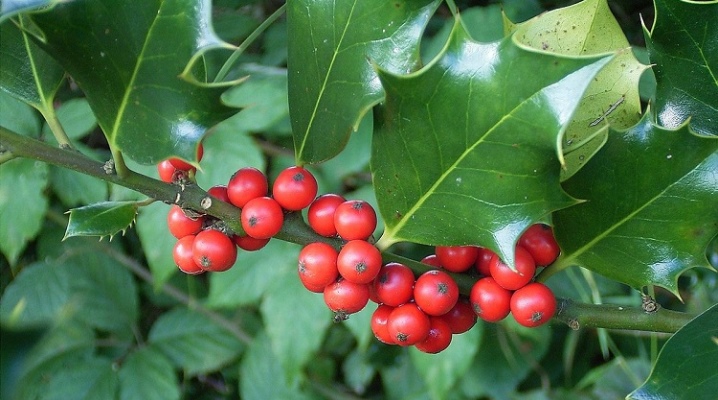
Holly (holly) is most often a shrub with evergreen foliage. Sometimes there are species in which the foliage falls off in cold weather. Mostly holly bushes can be found in countries with tropical or temperate climates. Holly gained the greatest popularity among gardeners due to its voluminous crown with extravagant bright leaves and expressive fruits of different colors.



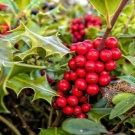
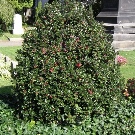
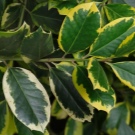
Description
Holly can be represented as dense vines, bushes and trees. The leaves are green in color from light to dark tones, often two-colored. The edges of the leaf plate are completely flat, with thorns, carved. The holly flower does not stand out much, not being particularly decorative. In the spring, the axils of the leaves are filled with light, small flowers. It is important to know that plants are male and female with appropriate flowering.
There are some types of holly in which both types of inflorescences are present on the same bush, but they are very rare. Over time, berries appear in place of flowers. They can be white, black, yellow, but most often orange or red. The fruits look quite attractive, do not lose their color throughout the winter months.
A person should not eat holly berries, as they are poisonous to him. As for birds, the holly is not dangerous for them.
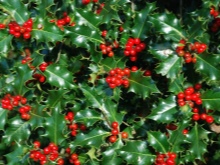
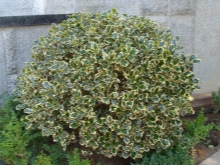
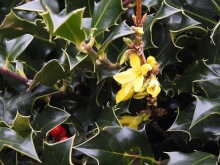
Under natural conditions, the height of the holly can reach 20 m or more. However, the cultivated plant often looks like a shrub to make it easier to care for it. Turning a holly into a bush can be done easily if you trim it regularly. The shape of the leaves is usually simple, their length varies from 8 to 25 cm, and their width is from 4.5 to 8.5 cm. From the characteristics of the foliage, it is also worth mentioning that they are leathery, thick and alternate.
On the front side, the leaf is usually painted in a dark green color, has a shiny surface. The lower part is always lighter and more matte. On all sides, the foliage is without pubescence, but the central vein is very pronounced. Holly grows in places with a warm climate, on loose soils with moderate humidity. It tolerates frost well up to minus 15 degrees.

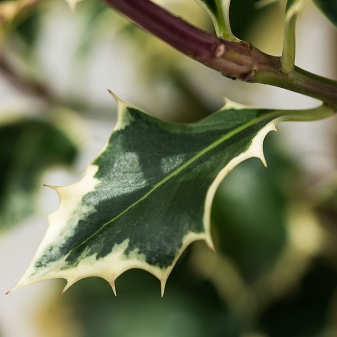
Overview of species and varieties
More than 450 species are found in the genus of holly. In ancient times, the common holly was used to protect their homes from the intrigues of "evil spirits". The shrub gained fame even before the time when the Roman Empire was founded. Various peoples (including the Slavs, Scandinavians and Celts) very often used the branches of this plant for different purposes.
Christmas wreath and garlands in many countries invariably contain this amazing plant with bright berries. And also they can often be seen on greeting cards and gift wraps in various European countries. The high vitality of the tree has made the tree very popular, especially in places with dense shade, where other vegetation takes root with difficulty.
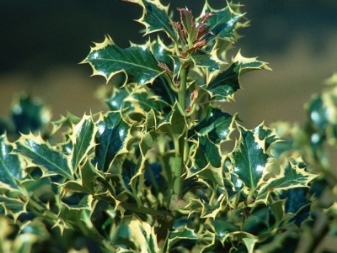
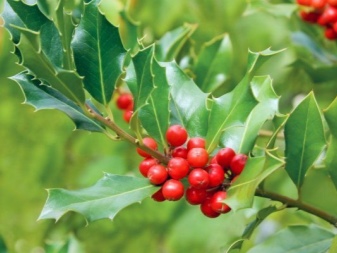
Common or holly
Most often found in the wild in southern Europe, as well as in North America and Asia Minor. The holly species itself is an evergreen shrub or tree. The height of the latter can reach more than 15 m.The branches are often short and spreading, forming a dense crown (oblong or pyramidal). The oblong ovoid leaves have short petioles, wavy edges and large triangular prickly teeth. The white flowers have short stalks and a fragrant aroma. The diameter of the fruits is less than 10 mm, and their shape resembles a ball. The color of the berries is most often red, they are collected in small brushes.
This species is characterized by slow growth, frost resistance, shade tolerance. Form trees in the form of pyramids or balls. The plant can be 100 years old or more. Varieties of varieties can differ in crown, color, leaf shape and fruit color. It adjoins well with spruce, fir and beech.
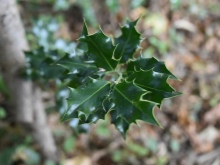
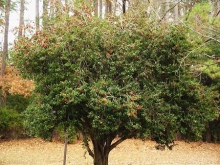
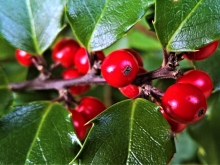
One of the brightest representatives of the species is the Golden King holly with variegated foliage. The cultivated plant has a wide irregular crown that grows up to 5 m.
Well suited as a living fence, as well as single bushes in the middle of the lawn.
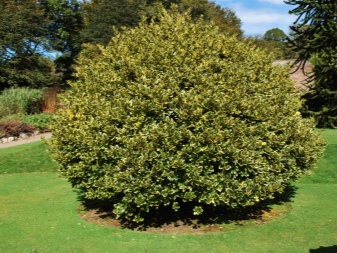

Another interesting variety is "Argentea Marginata", having a dense spreading crown in the form of a rounded pyramid. The variegated (variegated, spotted) leaf attracts with its color, which contrasts with the bright red fruits.

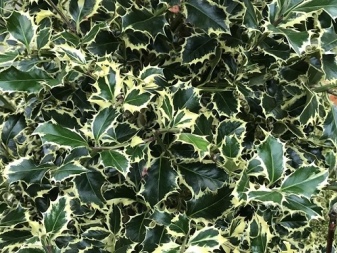
Evergreen
One of the most ornamental types of holly, it comes from the countries of North America. It is often called marsh, as it is found in very humid places. The branches are strikingly beautiful with round, bright orange berries. Very often, the shrub is used in flower shops to create original compositions. The whorled species is demanding in terms of care. It should be grown in humus soils. In this case, it is advisable to choose the south side of the garden with sufficient shade.
Among the evergreen subspecies, the Paraguayan holly with a height of 1 to 6 meters attracts attention. The leaves of these plants can reach 16 cm in length and be sharp at the edge. Fruits are small, red in color. Mostly found in South America.
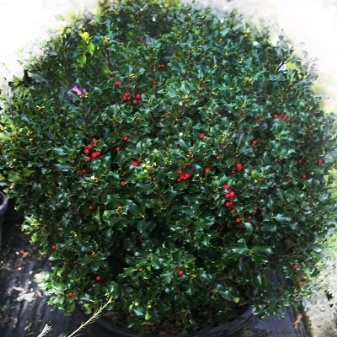
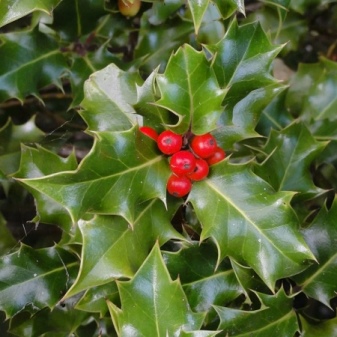
Chinese or broadleaf
In China and Japan, you can find a species with wide leaves. The large size of the leaves with a shiny bloom attract attention at first glance. The flowering of the varieties of this species is weak, so there are very few berries on the bushes.
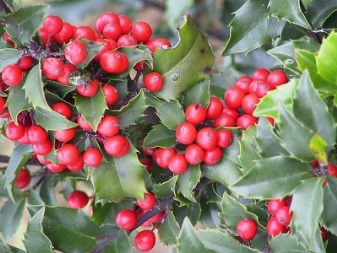
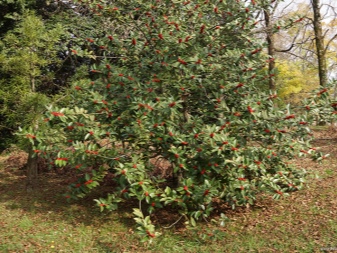
Crenate
Holly with this name can be found on Sakhalin and the Kuril Islands. Holly looks like a tree up to 7 meters high, sometimes - a shrub. Differs in greenery, which has a decorative appearance. Dwarf varieties of this species are found in Japan, the Caucasus and Crimea. The fruits are black in color, and the pause between flowering can be from 12 to 24 months.

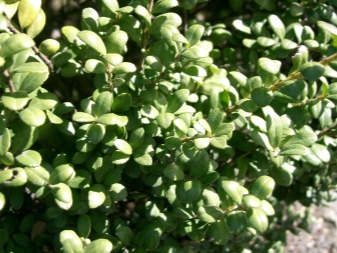
Mezerva
The species is a hybrid, obtained on the basis of three at once: ordinary, Korean and wrinkled. The leaves are green with a bluish tint. The color of the berries can be white, yellow or red. A distinctive feature of the variety is its high frost resistance, which makes it possible to grow varieties even in the Moscow region. Among the most common are "Heckenstar" and "Heckenfy", the advantages of which are simplicity in care and durability.
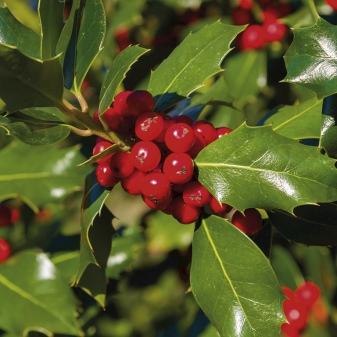
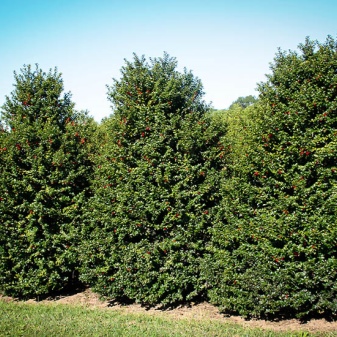
Colchis
This species has small fruits and expressive veins on the leaves. Initially, the plant grew on the territory of the Caucasus and Asia Minor. Most often, Colchis holly is a tree with drooping branches, less often a shrub with a creeping crown. The leaf is prickly, toothed, leathery, dark green in color.
At times it can freeze without sufficient snow cover, but then it quickly recovers.
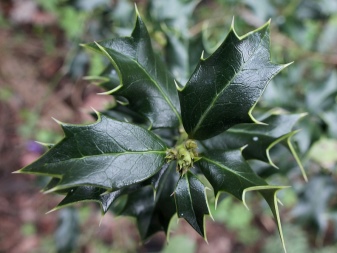
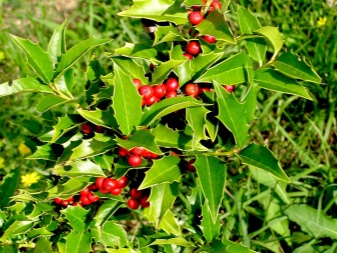
Landing rules
For planting holly plants, it is advisable to choose fertile and loose soil. It will be very good if it is breathable and drainable. Of course, it is possible to grow holly on poor soil, but considerable efforts will have to be made. In any case, to grow healthy plants, it is necessary to improve the land with leaf humus, sand, peat, turf.It is best to mix all of the listed ingredients in equal proportions.
The only soil that is absolutely unsuitable for this plant is calcareous. It is important that the site is well lit by the sun or in partial shade. However, even shaded areas are suitable for holly. For very open lands, it is worth choosing varieties with variegated leaves. In the first time after planting, it is necessary to regularly water the plant.
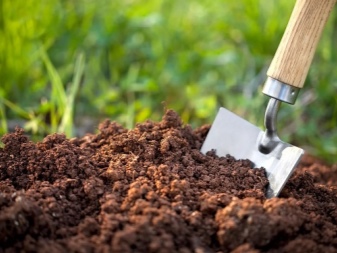
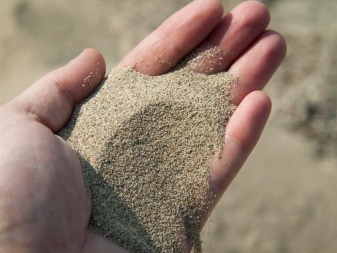
Autumn is considered the ideal time for planting. This is so that the shrub can take root better. In the spring of planting, you should choose a time when there will definitely be no more frosts. An important point for the holly is protection from the winds. As a planting material, you should choose strong and healthy shoots with flexible branches, live buds and a developed root system. It is necessary to prepare a hole with a depth and width of 70 cm. It is good if its volume is 2 times larger than the seedling earth's clod.
The bottom must be covered with a layer of drainage, and then a layer of soil must be applied to it. Only after that, the roots of the plant are distributed and the depression is filled with evenly prepared soil. It is advisable to carry out a gradual compaction of the earth. It is important to ensure that the neck of the plant is at the same level as the surface. The last stage in planting is watering, in which at least 10-15 liters of water must be spent on one bush.
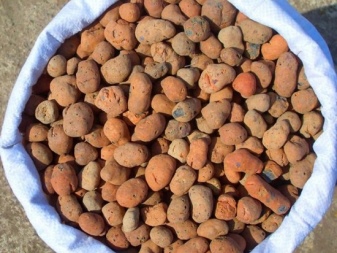
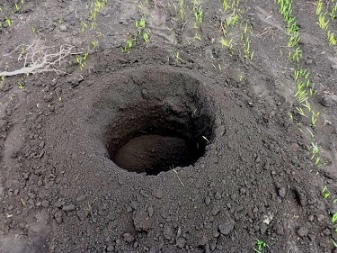
Care Tips
In the first seasons, soil moistening should be carried out at least once a week. Then watering depends entirely on the amount of rainfall at a certain time of the year. Shrubs do not like either excess moisture or lack of it. If the weather is too hot and dry, it is worth spraying the crown as well. Holly need periodic feeding with the use of fertilizers. In the spring months (before the beginning of the growing season), it is worth feeding with compost and complex minerals. In warm weather, plant feeding should be done 2 times a month. For this, you can use any organic matter, phosphorus, potassium and other suitable substances.
It is important to keep the soil under the plants clean by regularly removing weeds. And also it is constantly necessary to loosen the soil of the trunk circles to a depth of 5 cm. As a prophylaxis against parasites, you can use insecticides. Once a year, branches damaged by frost and disease should be pruned. As for decorative haircuts, they are carried out no earlier than the tree reaches the age of 4 years.
In winter, plant roots should be insulated with a layer of leaves or sawdust. In severe frosts, agrofibre or burlap can be used to cover the crown.

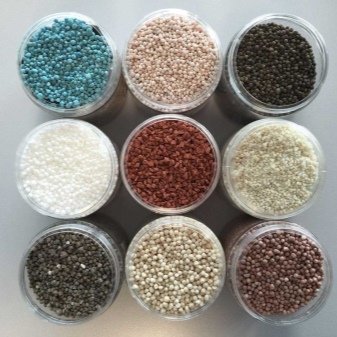
Reproduction
Holly can be propagated either by sowing seeds or by cuttings. For the first method, it is important to stratify the material over a period of 16-18 months. It should be clarified that under natural conditions this process takes place in the digestive tract of birds. For a cultural breeding method, cuttings are often chosen. This makes it easier to preserve the varietal qualities of a particular holly variety. For cuttings, you need to take a semi-lignified shoot. Slices should be done with a sharp garden knife. It is necessary to cut the material into pieces with a length of 40-50 mm. At the same time, there should be 2 internodes on each cutting. The cut is necessarily beveled.
Immediately after cutting, the cuttings must be planted in a greenhouse. Prepare the soil in advance from humus and sand in a ratio of 3 to 1. The prepared material should be planted to a depth of no more than 20 mm. It is important to regularly spray the soil with cuttings, cover it from excessive sunlight, and keep the temperature constant. As a rule, it takes 14 to 30 days for rooting. If the roots of the cuttings have developed well, then they can be safely transplanted to a permanent place.
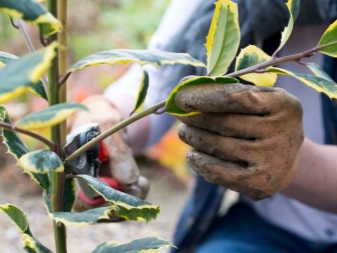
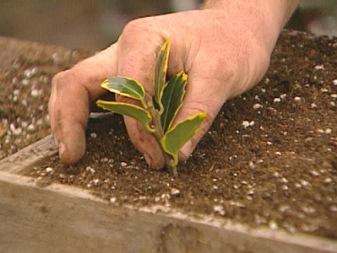
Diseases and pests
Of the pests for holly, the most dangerous are mealybugs, aphids, whiteflies and scale insects. If the air humidity is low, then you should be wary of the attacks of a spider mite. If parasites are found, the shrubs should be treated with insecticides. If the soil is excessively moist, then a disease called root rot may appear. Insufficient watering can be said if the holly has dropped flowers and berries, and sometimes even leaves. If a plant is damaged by a fungus, spots form on it. This problem is eliminated by removing the affected foliage and treating the shrub with a suitable fungicide.
Heat has a negative effect on holly. It is especially necessary to shade species with dark leaves, as well as young plants, as they can get sunburn. Phytophthora is dangerous for holly in that it most often affects the root system, as a result of which the entire plant dies. It is impossible to cure this disease.
If any of its signs appear, then it is necessary to dig up the tree and burn it. The land in which the plant was located must be disinfected.
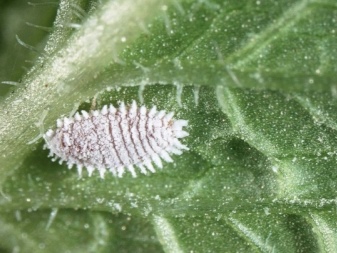
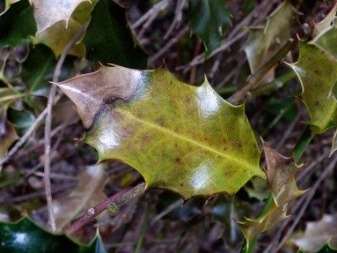
Application in landscape design
You can plant holly in your garden plot either in groups or singly. The holly hedge looks very impressive. Moreover, it is also a reliable protection against strong gusts of wind. And there are also varieties that grow well, which are best suited for topiary and bonsai styling.
In the garden, holly can be safely supplemented with hydrangea or euonymus. These plants add up to harmonious compositions. In addition, they can choose various conifers as neighbors. Among the most expressive and attractive are hybrid varieties with variegated leaves. Solitary trees and bushes look great in combination with regular lawn grass, as they remain very bright throughout the year.

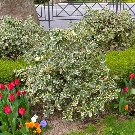
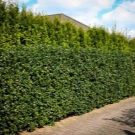

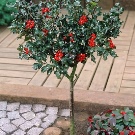






























































The comment was sent successfully.